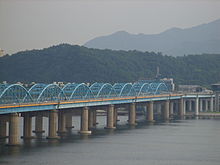Dongjak Bridge
- Machine translation, like DeepL or Google Translate, is a useful starting point for translations, but translators must revise errors as necessary and confirm that the translation is accurate, rather than simply copy-pasting machine-translated text into the English Wikipedia.
- Do not translate text that appears unreliable or low-quality. If possible, verify the text with references provided in the foreign-language article.
- You must provide copyright attribution in the edit summary accompanying your translation by providing an interlanguage link to the source of your translation. A model attribution edit summary is
Content in this edit is translated from the existing Korean Wikipedia article at [[:ko:동작대교]]; see its history for attribution. - You may also add the template
{{Translated|ko|동작대교}}to the talk page. - For more guidance, see Wikipedia:Translation.
| Dongjak Bridge | |
 Dongjakdaegyo | |
| Korean name | |
|---|---|
| Hangul | 동작대교 |
| Hanja | 銅雀大橋 |
| Revised Romanization | Dongjakdaegyo |
| McCune–Reischauer | Tongjaktaegyo |
The Dongjak Bridge (Korean: 동작대교) is a bridge over the Han River in Seoul, South Korea. It carries road traffic and Seoul Subway Line 4, and Dongjak Station is located at the southern end of this bridge. It is a blue truss bridge.[1] It is the 11th bridge overall, and the fifth railroad bridge to be completed across the Han River. Dongjakdaegyo was completed on the same day as Donghodaegyo, which has a similar structure.
History
Construction on Dongjakdaegyo commenced on October 18, 1978, and Seoul Mayor Jachoon Gu, Deputy Prime Minister Deokwoo Nam, and Minister of Construction Hyeongshik Shin participated in the groundbreaking ceremony. At the time of commencing construction, Dongjakdaegyo was the first bridge in Korea to have the langer-arch design, and was scheduled to open in September 1981. The reason for using the langer-arch design for this bridge was because a steel plate was used instead of a concrete plate for reducing the bridge weight by designing to allow the Seoul Line No. 4 to pass. At the time, the construction of Dongjakdaegyo was carried out as construction of a civil investment method by the investment and construction delegated to Daewoo Development, similar to Wonhyo Daegyo, therefore there was a plan to receive toll fares for a period of 20 years. At the time of construction, Dongjakdaegyo was the widest bridge in Korea.
- October 18, 1978: Construction started
- February 1980: Construction completion time extended to December 1981
- 1981: Construction suspended due to Daewoo Construction returning the construction project
- February 1982: Construction resumed
- December 1983: Construction completion time extended to the end of 1984
- February 1984: Announcement of plan to open in September with only six vehicle lanes
- November 14, 1984: Completed and opened
References
- ^ (in Korean) 동작대교 銅雀大橋 (Dongjak Bridge) Archived June 10, 2011, at the Wayback Machine Nate / EncyKorea, retrieved on July 13, 2009
- v
- t
- e
37°30′40″N 126°58′56″E / 37.5112°N 126.9822°E / 37.5112; 126.9822
  | This article about a specific bridge or group of bridges in South Korea is a stub. You can help Wikipedia by expanding it. |
- v
- t
- e










